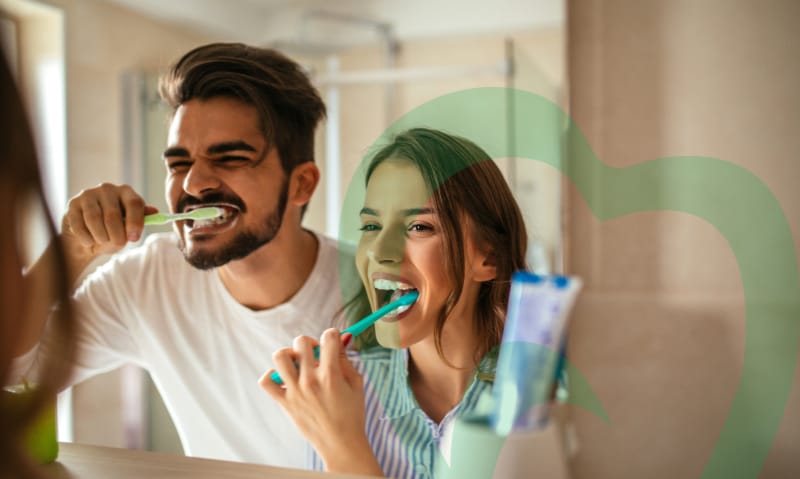The Right Toothbrush: Which One Is the Best for Me?

When it comes to brushing our teeth, finding the best kind of toothbrush is more important than we might realize. After all, we spend a lot of time brushing our teeth. It’s true! For a typical 79-year-old lifespan, a person will spend more than 82 days brushing their teeth. Finding the best kind of toothbrush does matter when done so frequently.
How to find the best kind of toothbrush
As we said, you’ll spend a lot of time brushing your teeth throughout the years. Each day alone, you’ll spend about four minutes cleaning and brightening your pearly whites. Unfortunately, many people don’t know what to look for in the right toothbrush. Since there are so many do’s and dont’s of home dental care we thought we would make it a bit easier for you by sharing six tips you should remember the next time you walk through the dental aisle.
1. Soft-bristled is best
Adults often think they need a medium or hard-bristled brush to clean off all the dental plaque that builds up during the day, but a soft-bristled toothbrush is less densely packed. This means that the bristles can bend easier and are gentler on your teeth and gums. The design of the soft bristles also makes it easier for your toothbrush to get into those hard-to-reach spaces.
2. Manual vs. electronic
Your typical manual soft-bristled toothbrush can undoubtedly do the job, especially if you have good dexterity and muscle control. But, there are many benefits to electronic toothbrushes, especially for those with less hand strength and coordination. Electric toothbrushes are gentler on the gums (especially for those who like to take out their aggressions by brushing too hard with a manual toothbrush) and help clean better along the gum line.
3. Toddler toothbrushes
Parents must look for toddler toothbrushes that are easier for kids to manage. Little hands can’t quite hold onto a toothbrush the same way older kids and adults can. So, if you are looking for the best kind of toothbrush for your toddler, start by looking for one with a smaller head and a thicker handle. Be on the lookout for one with an ADA-approved seal on the manufacturer’s packaging. And if you can, look for one with a timer to help teach your child how long to brush (two minutes twice a day).
4. Toothbrushes for braces
If you or someone at home has braces, you know that brushing teeth with braces can be a bit trickier. With braces, you need to be able to get at food particles that like to hide between or behind the brackets. Look for a toothbrush with a narrow neck and an ergonomic or angled handle to help you get in and brush away those pesky particles. The best kind of toothbrush for braces will have a round brush head with soft, flexible bristles.
5. Toothbrushes for sensitive teeth
Sensitive teeth can make oral care more complicated. But, finding the best kind of toothbrush for sensitive teeth doesn’t have to be tricky. Stick to a soft-bristled toothbrush, but look for one with a smaller head. That smaller head can make it easier to gently get at those hard-to-reach places. But, most importantly, remember that brushing too hard or using a toothbrush with hard bristles can increase tooth sensitivity and wear down dental enamel. So, stick to a soft-bristled toothbrush with a round head, and brush softly with a dentist-approved sensitive toothpaste for best results.
6. Technique is everything
When it comes to brushing your teeth, even if you have the best kind of toothbrush, technique often trumps everything else. The most effective way to rid your mouth of bad oral bacteria and dental plaque is to hold your toothbrush parallel to your teeth but tilted at a 45-degree angle. Angling the toothbrush will help get at the gum line better. Using gentle but firm pressure, brush back and forth or in a circular motion about 15 times before you move on to the next area.
Be sure to get all of your teeth—all outer surfaces and inner surfaces—and spend a total of two minutes brushing your teeth twice daily. The best times to brush your teeth are in the morning after breakfast and before bed, right before flossing and rinsing with a fluoridated mouthwash.
Talk to your dentist near Omaha, NE about the best kind of toothbrush for you.
If all else fails and you have remaining questions about the best kind of toothbrush, remember that your favorite dentist near Omaha is here to help. If you live or work in Omaha, NE, be sure to request an appointment for your next dental cleaning and oral examination with The Tooth Doc. We offer comprehensive dental care for the entire family and can help ensure that everyone in your family, regardless of age, finds the best kind of toothbrush for their needs.